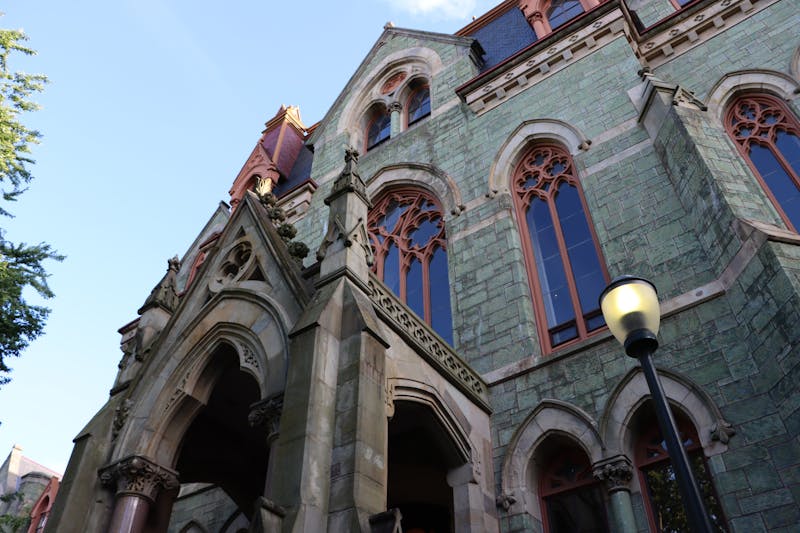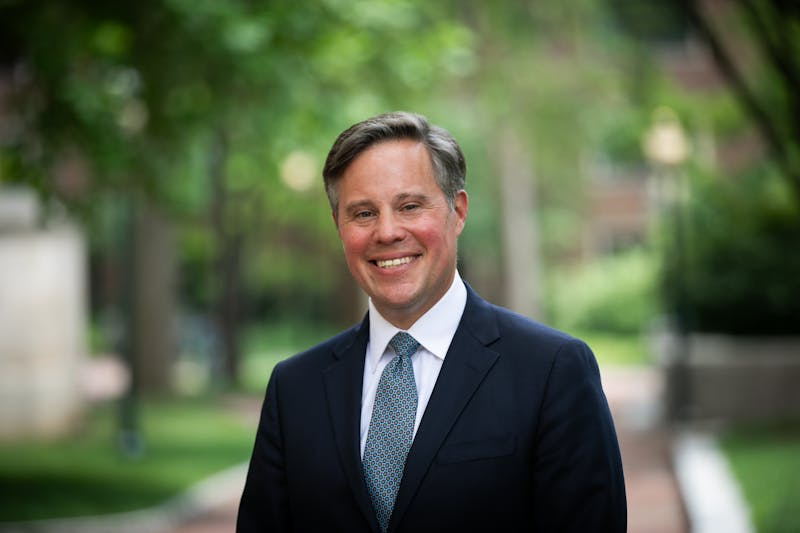
In 1955, five Division I basketball programs in the Philadelphia area -- Penn, Saint Joseph's, Temple, Villanova and La Salle -- came together and decided that they would all play each other in a round-robin format each season.
Since then, thousands of people have helped shape the Big 5 into a truly unique sports tradition. They have so many stories that it would be impossible to tell them all at once.
These are just a few of them.
The player turned A.D.
To one generation of Penn basketball fans, Steve Bilsky is known for his work in the Palestra, as a captain of the Quakers and three-time all-Ivy League guard who helped launch a decade of Red and Blue dominance in the 1970s.
To the generation that followed, Bilsky is better known for his work down the street in Weightman Hall, as Penn's athletic director since 1994.
Between the two eras, there has been a lot of change in the City Series. Some things, though, have stayed the same.
"The consistency between the two is that the Big 5 has been around for 50 years, and the Palestra has been the Mecca of the Big 5," he said.
But he acknowledged that the Big 5 has lost some of its luster in the modern era of college basketball.
"The focus now, clearly, for all the schools, is on the conferences, and the Big 5 is a secondary factor," he said. "Back then, the Big 5 was probably as important as anything else you did."
Bilsky spent 11 years as the athletic director at George Washington in the nation's capital -- where there is plenty of college basketball tradition thanks to Georgetown, Maryland and a number of other Division I schools.
Yet D.C., like so many other cities, has never been able to put together anything like the Big 5.
"New York, Chicago, Washington, Los Angeles -- every major city has at least the number of Division I institutions that Philadelphia has," Bilsky said. "They've all said, boy, wouldn't it be neat if we could do something like this, and no one's been able to even come close to anything like it."
Which is perhaps the main reason why Bilsky and his fellow athletic directors have kept the Big 5 going.
"That's the principle that I think drives all of us to look at the whole rather than the institutional selfishness, he said.
The Explorer turned Owl
Bill Bradshaw walks around these days with a Temple pin on his blazer. But it wasn't that long ago that he represented North Philly's other Big 5 school -- La Salle.
From 1978 to 1986, Bradshaw was the athletic director on Olney Avenue, where he saw four-time all-Big 5 forward Michael Brooks star for the Explorers. He then left for Chicago to run DePaul's athletic department, before returning to Philadelphia in 2002.
This time, though, he turned off Broad Street at Cecil B. Moore Avenue. He has worked there ever since.
Bradshaw acknowledged that the two schools have little in common.
"There are major differences -- in football, in the budgets, in the enrollments," he said.
Still, Temple and La Salle face off every year, with both city and Atlantic 10 conference bragging rights on the line.
"That's the beauty of the Big 5," Bradshaw said. "Having five institutions that represent different missions of the universities, different budgets, different enrollments, different conferences."
That unity was tested two years ago, when Temple and Villanova struggled to fit their annual game into tight non-conference schedules. But at the last minute, a deal was struck to meet at midnight on the first day of the season.
"It was very close to not happening, but it was very close to happening," Bradshaw said. "Everyone involved moved closer at the end to have it happen. That meant Villanova had to sacrifice and compromise, Temple had to sacrifice and compromise; Jay Wright did. John Chaney did."
To so many people, the Big 5 is always worth fighting for -- no matter what time it is.
The custodian
If you've ever been in the Palestra for a game, you've surely seen Dan Harrell somewhere. Maybe you've seen Harrell's gold shoes, or his mop, which he carried down Locust Walk when he graduated from Penn in 2000 at the age of 56.
But if you came to the Palestra before Harrell started working there 16 years ago, you saw him as a fan who took the streetcar with his friends from Southwest Philadelphia to 33rd Street.
"We all, as kids growing up, had a strong feeling for the Big 5," he said.
Harrell said he misses the days when there were more fans like him, who came from all over the city to watch games even if they weren't affiliated with one of the schools.
"Years ago, you didn't have to go to St. Joe's, you didn't have to go to Villanova, you didn't have to go to Penn -- you just adopted a school and were a fan," he said.
Because Harrell's office is located in the Palestra, he spends a lot of time in the building when there aren't any other people around. But he said that "the building is never really empty."
"It speaks to you," he said. "It's a special place -- it's like being with a person."
The gold shoes, by the way, were created as an emergency replacement for his Mummers' Parade costume six years ago.
While moving from Southwest Philadelphia to Prospect Park, Harrell packed his usual gold shoes so far down that he couldn't get at them. So he went to the Palestra and painted his work shoes gold.
Penn had practice that day, and the Quakers -- in particular Ugonna Onyekwe, Koko Archibong and Duane King -- noticed the new attire.
"They called them Air Dans," Harrell said.
The shoes might have changed, but Harrell's enjoyment of Big 5 games has not.
"I still get pumped up," he said. "I still get goosebumps."
The scribe
Jack Scheuer went to work for The Associated Press in 1968, and he's been covering Big 5 basketball ever since. If there's a big game going on at the Palestra, he'll be there, front and center on press row.
Scheuer has covered college basketball in Philadelphia for so long that he struggled to pick out a favorite memory.
"There have been so many," he said.
He finally settled on the 1985 Villanova-Georgetown national championship game and the 1966 Saint Joseph's-Villanova game -- in which reserve guard Steve Donches hit a 29-foot buzzer-beater to win that year's edition of the Holy War.
"It's one of the great St. Joe's victories," Scheuer said.
The old days, when all five teams played at the Palestra frequently, were "heaven" for Scheuer. It's different nowadays, though, when teams can play Big 5 games on their own campuses.
Still, the Palestra remains the beating heart of Philadephia basketball, and it leaves an impact even on those who come from elsewhere to play there.
Such as when Roy Williams brought the Kansas Jayhawks to play Penn in 1998.
"He was awed," Scheuer said.
Scheuer said that the Big 5 may not get the respect it deserves nationally from the media.
"But again, I'm prejudiced," he said, "because I love the Big 5."
Scheuer may be a reporter, but he is a human being as well.
The Hawk personified
A lot of people have come and gone since 1976 on the part of City Avenue known as Hawk Hill. For all but eight of those nearly 30 years, though, Don DiJulia has been a constant, as the athletic director at Saint Joseph's.
DiJulia was a player on the 1965 Hawks team that finished ranked in the top 10 under legendary coach Jack Ramsay. DiJulia took over the program's top job in 1976, left in 1981, and returned to the same position in 1988.
In his time as athletic director, the Hawks have become known for playing big games at the Palestra instead of the on-campus Alumni Memorial Fieldhouse.
They have done so in part as a matter of convenience, as the Palestra's 8,722-seat capacity dwarfs the Fieldhouse's 3,200 seats. But there have also been sentimental reasons to make the trip down the Schuylkill Expressway.
"It's become like a home away from home for our community," he said. "It's meant a lot for us, and it's a key part of our history."
With the Hawks' success in recent years, there has been talk of building a new on-campus arena. But DiJulia said that even if that happens, the team will still play some games at the Palestra.
"We would still need a larger facility off-campus to be able to schedule teams that just would not come to campus," he said. "Even to the degree that we wouldn't need it, because it's been a key part of our history, we would definitely play all the local games here, just because we want as many fans as possible to see us play."
Hawks traditions, it is said, will never die.
The Daily Pennsylvanian is an independent, student-run newspaper. Please consider making a donation to support the coverage that shapes the University. Your generosity ensures a future of strong journalism at Penn.
DonatePlease note All comments are eligible for publication in The Daily Pennsylvanian.







